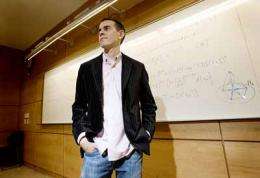Mathematical models key to tracking gossip, terrorists

(PhysOrg.com) -- Thanks to the Internet and online social networks (OSNs) news and gossip now spread literally like wildfire -- uncontrollably and seemingly without any order. But according to one Ryerson researcher, there is method to the madness. With the right mathematical model, you could spot when and where a story starts, then watch as it skips across the Internet. One day, similar models could even detect and track terrorist cells within OSNs.
An associate professor in Ryerson’s Department of Mathematics, Anthony Bonato creates models to explain the complex connections behind online communities. Bonato’s work holds great promise in three disparate areas: following online gossip and news, extending the reach of advertising by identifying and targeting intended audiences and, most importantly, finding terrorists. Currently, it is extremely difficult to spot terrorist cells within OSNs. By applying the appropriate theorems, however, the evolution of those groups could one day be accurately detected and tracked.
Networks such as Facebook, Twitter and LinkedIn have quickly become communication juggernauts, providing a vast and unprecedented record of social interactions. But they’ve left mathematicians struggling to keep up. First and foremost It is a challenge for researchers to visually convey the intricate systems that make up OSNs.
“In a social network, it’s hard to define what actually constitutes a community,” Bonato explains. “You need to study an OSN’s structure of links, but in mathematics there are several ways to tackle the problem and then apply the resulting theorem. The question is which process and theorem will work best?”
Bonato cautions there is still much work to be done, but many successes have already been achieved by his research team, which consists of graduate students and a post-doctoral fellow. Their process of discovery involves the use of anonymous data from social networking websites such as LiveJournal and Flickr. Vertices are identified with people and edges are shown to correspond with some kind of social interaction, such as friendship. Patterns found in the data then point to new models posed in the language of graph theory, which is an active branch of modern mathematics.
The mathematician likens his work to that of a composer - his team is trying to find the right combination of formulas, only instead of musical notes, they work with numbers and concepts. Moreover, the experimental nature of mathematics means that new findings require theorems to be changed constantly. While it can be a frustrating process, it is also one that Bonato finds exhilarating.
“New findings are coming along all the time that require theorems to be reformulated,” he says. “A great deal of your time and work may lead nowhere, but you just keep trying to find and carefully analyze the right model.”
Later this month, Bonato will present his research (A Survey of Properties and Models of Online Social Networks) at the International Conference on Mathematical and Computational Models in India.
Provided by Ryerson University

















